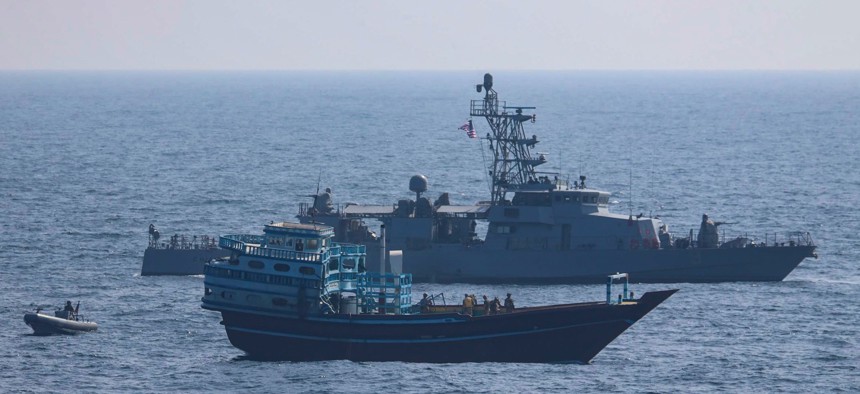
U.S. service members conduct a boarding on a stateless fishing vessel transiting international waters the Gulf of Oman as a rigid-hull inflatable boat and patrol coastal ship USS Chinook (PC 9) sail nearby, Jan. 18, 2022. U.S. Navy
New Navy Task Force to Protect Red Sea Region
Drug and weapons smuggling, as well as rocket attacks, undermine the security of the major shipping route.
The Navy is standing up a new multinational task force for the Red Sea region—where smuggling and missile attacks are a major concern—to increase coordination with regional navies and deterrence against illegal activities.
Combined Task Force 153 “will focus on international maritime security and capacity-building efforts specifically in the Red Sea, Bab el-Mandeb, and the Gulf of Aden. These are strategically important waters that warrant our attention and any destabilizing activity, including threats to commercial traffic and coastal infrastructure, really can have profound global impacts,” Vice Adm. Brad Cooper, the commander of Naval Forces Central Command, U.S. 5th Fleet, and Combined Maritime Forces, told reporters Wednesday.
The Red Sea is a major shipping route leading up to the Suez Canal, and is surrounded by several countries, including Saudi Arabia, Egypt, Djibouti, and Yemen. The region faces security issues including smuggling of drugs and weapons, and threats posed by Houthi rebels from Yemen, who have launched attacks on Saudi Arabia and a missile into the Red Sea itself in March
Combined Maritime Forces is a U.S.-led naval partnership with 34 nations. It has three other task forces: one for counter piracy (CTF 151), one for maritime security operations inside the Arabian Gulf (CTF 152), and one for maritime security outside the Arabian Gulf (CTF 150). The new task force will allow CTF 150 to keep its focus to just the Gulf of Oman, the North Arabian Sea, and the waters from the North Arabian Sea down to the Yemen-Oman border, Cooper said.
One of the task force’s missions is to stop the flow of illegal drugs and weapons. Cooper said its command structure and coordination with other navies that regularly patrol the waters will increase deterrence against illegal activities in the region.
“More specifically, I think we'll find ourselves better positioned to deal with the range of challenges that we face in terms of smuggling in both drugs and weapons that are well documented in the region,” he said.
The task force will not increase the number of ships or planes in the region; Cooper said there are already enough to accomplish the mission. Ships are moved around the 5th Fleet area and to the different task forces based on the mission and its requirements.
“So it's a very fluid, dynamic arrangement. And both for U.S. as well as our partner nations, the number of ships and aircraft that are committed are highly variable based on the priorities and based on what we're trying to achieve,” he said.
The new task force will officially stand up April 17 at U.S. 5th Fleet headquarters in Bahrain and will be led initially by a U.S. Navy officer. Then, the task force staff will embark on the amphibious command ship USS Mount Whitney for initial operations. Cooper said they expect the task force will be led by a regional partner later this year.




